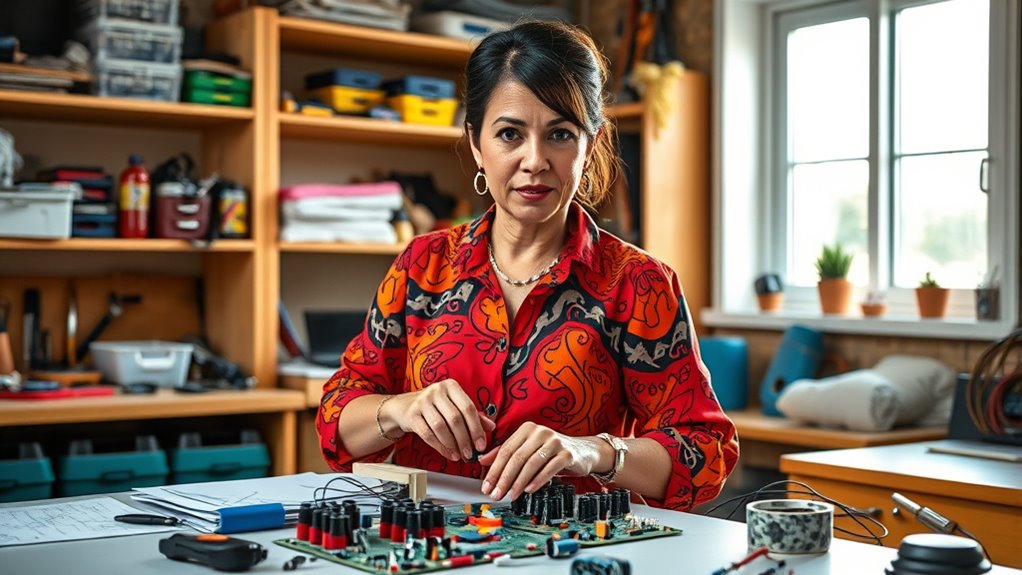To overcome the double bias of gender and hearing loss, you can promote inclusive communication by using assistive technologies like captioning and sign language interpreters. Foster a workplace culture that recognizes achievements of Deaf women and challenges stereotypes through awareness and mentorship. Support accessibility with proper policies and visual tools, and celebrate their leadership. By actively creating a respectful environment, you’ll see how understanding and solid strategies help break down barriers—exploring further reveals powerful ways to make a difference.
Key Takeaways
- Implement inclusive policies, accommodations, and assistive technologies to eliminate communication barriers for deaf women.
- Promote awareness and training to challenge stereotypes and reduce societal biases related to gender and hearing loss.
- Highlight and celebrate deaf women’s achievements to inspire confidence, visibility, and leadership opportunities.
- Foster mentorship and networking programs that empower deaf women and showcase successful role models.
- Create a workplace culture of openness, respect, and accessibility to support deaf women’s full participation and advancement.
Navigating Workplace Biases and Stereotypes

Have you ever wondered how deaf women face biases and stereotypes in the workplace? Cultural perceptions often shape how others see your abilities, leading to misconceptions about your competence. Society’s expectations can pressure you to conform to traditional roles, doubting your leadership or communication skills simply because of your hearing loss. You might encounter assumptions that you’re less capable or that your condition limits your potential. These biases are reinforced by stereotypes that overlook your skills and achievements. Steering through this landscape requires resilience, as you challenge outdated beliefs and demonstrate your value beyond societal labels. Recognizing these ingrained perceptions is the first step toward breaking down barriers. You deserve recognition for your talents, not judgments based on prejudice or misconceptions. Additionally, understanding the role of AI in security can empower you to advocate for accessible and inclusive technologies that support diverse needs in the workplace. As automation technologies continue to evolve, they offer promising tools to enhance communication and accessibility for deaf professionals. Embracing innovative solutions can further bridge communication gaps and promote workplace equity. Moreover, leveraging assistive communication tools can help dismantle communication barriers and foster a more inclusive environment for deaf women. Incorporating advanced hearing devices can also improve daily interactions and boost confidence in professional settings.
Communication Barriers and Accessibility Challenges

You might find that communication barriers still hinder your ability to connect effectively at work. Limited access to sign language interpreters or assistive tools can make it harder to participate fully. Addressing these challenges is essential to creating an inclusive, accessible environment for everyone. Incorporating assistive communication tools can significantly improve interactions and foster a more equitable workplace. Recognizing the importance of exploration and discovery can inspire innovative solutions to overcome persistent communication hurdles. Additionally, understanding how mindfulness practices can promote focus and reduce stress may help in developing more empathetic communication strategies. Developing a remote work mindset can further enhance adaptability and resilience in overcoming these barriers. Emphasizing support systems can also contribute to building a more understanding and accommodating work environment.
Sign Language Accessibility
Sign language accessibility remains a significant challenge in many workplaces, often limiting deaf women’s ability to communicate effectively. Without proper support, communication access issues persist, creating barriers to collaboration and inclusion. To improve this, consider:
- Providing on-site sign language interpreters to facilitate real-time communication.
- Ensuring meeting rooms are equipped with visual aids and adequate lighting.
- Training staff on basic sign language skills to foster inclusive environments.
- Implementing policies that prioritize communication access for all employees.
- Regularly assessing and adjusting communication strategies to align with inclusive practices maximize space and organization.
- Recognizing that attention plays a crucial role in effective communication and creative engagement, training can help staff develop better focus during interactions, thereby improving overall accessibility. Incorporating visual organization tools can further enhance clarity and reduce misunderstandings during exchanges, especially when clear communication channels are established. Additionally, understanding the importance of active listening and empathy can significantly improve interactions and foster a more inclusive atmosphere.
Assistive Communication Tools
Assistive communication tools play a crucial role in overcoming the barriers faced by deaf women in the workplace. Augmentative devices, like hearing aids or cochlear implants, can improve hearing ability, but they might not be enough in noisy environments. That’s where captioning services come in—real-time captions during meetings or presentations help you stay engaged and understand information fully. These tools make communication more accessible and reduce misunderstandings. Additionally, many workplaces now use specialized software that transcribes spoken words into text instantly. By leveraging these assistive technologies, you can participate more confidently, demonstrate your skills effectively, and break down the double biases tied to gender and hearing loss. Improved communication tools are essential for understanding language accessibility, which often relies heavily on dialogue and sound cues. These innovations ensure that deaf women can engage fully in professional settings without feeling excluded. Moreover, some organizations are adopting analytical cookies to better understand how employees utilize communication tools and improve accessibility solutions. Recognizing the importance of sound synthesis and other inclusive policies further supports the integration of deaf women into the workplace. Ultimately, these tools empower you to succeed and thrive professionally.
Strategies for Inclusive Work Environments

Creating an inclusive work environment for deaf women requires intentional strategies that address communication barriers and promote equal participation. You can foster this by implementing clear policies and encouraging workplace mentorship programs. Additionally, providing training on privacy policies ensures staff understand data protection related to communication accommodations. Consider these strategies: 1. Promote policy advocacy to ensure workplace accommodations and anti-discrimination policies are enforced. 2. Establish mentorship programs pairing deaf women with allies to support career growth. 3. Offer training to educate staff on effective communication and inclusivity. 4. Use technology, like visual alerts and captioning, to facilitate better communication. Incorporating adaptive tools and devices can further improve accessibility and ensure all employees can participate fully. Leveraging security systems and monitoring can also enhance safety and confidence in the workplace environment. Moreover, staying updated on celebrity lifestyle insights and innovations can inspire creative solutions for inclusivity efforts. Utilizing data analysis to monitor the effectiveness of accommodations can help tailor ongoing support to meet diverse needs.
Celebrating Deaf Women’s Achievements and Leadership

You can see how Deaf women are making significant strides as leaders and role models. Their achievements break down gender barriers and inspire others to pursue their goals. Celebrating their success highlights the power of diversity and resilience in the workplace. Recognizing their contributions fosters a more inclusive community environment that values different perspectives. Emphasizing the importance of representation helps to challenge stereotypes and promote equity across various sectors.
Deaf Women Leaders
Deaf women have made remarkable strides in leadership across various fields, breaking barriers and challenging stereotypes along the way. Their success highlights the power of intersectional leadership and the importance of cultural representation. As leaders, they serve as role models, inspiring others to pursue their goals despite obstacles. Here are some ways Deaf women are leading the way:
- Advocating for inclusive policies that recognize diverse needs.
- Promoting cultural representation to increase visibility in mainstream spaces.
- Building networks that support Deaf women in leadership roles.
- Challenging stereotypes by demonstrating that hearing loss does not limit leadership potential.
Your recognition of these achievements underscores the importance of celebrating Deaf women’s leadership and their contributions to society.
Breaking Gender Barriers
Despite the many challenges they face, Deaf women continue to break through gender barriers and redefine leadership standards. Cultural perceptions often underestimate their abilities, shaped by societal expectations that prioritize hearing and traditional roles. Yet, Deaf women challenge these norms by demonstrating resilience and strength, proving that leadership isn’t limited by hearing status or gender. They actively push for recognition, inspire others, and show that diversity enriches workplaces and communities. By defying stereotypes, Deaf women reshape societal views on what it means to be a leader. Their achievements highlight the importance of valuing skills, determination, and innovation over outdated biases. In doing so, they pave the way for a more inclusive future where gender and hearing loss no longer define one’s potential.
Inspiring Role Models
Celebrating the achievements of Deaf women reveals inspiring stories of leadership and resilience that challenge stereotypes and motivate others. These role models demonstrate how communication innovation can break barriers and foster inclusion. Their journeys highlight the importance of leadership development, showing that success comes from perseverance and creativity.
Consider these inspiring figures:
- They pioneer new communication methods, inspiring others to innovate.
- They lead initiatives that promote accessibility and awareness.
- Their stories encourage others to develop leadership skills despite challenges.
- They serve as powerful examples that double biases can be overcome through determination and innovation.
The Role of Employers and Colleagues in Fostering Inclusion

Employers and colleagues play a crucial role in creating an inclusive environment where deaf women can thrive. You can promote cultural awareness by offering training that educates about hearing loss and gender biases, fostering understanding and respect. Recognizing the unique challenges deaf women face helps build a supportive workplace. Implementing mentorship programs connects deaf women with experienced colleagues who can offer guidance and encouragement, boosting confidence and career growth. Your proactive efforts demonstrate commitment to diversity and inclusion, breaking down barriers rooted in ignorance or misconceptions. By prioritizing open communication and accessible accommodations, you create a space where deaf women feel valued and empowered. Your actions directly influence workplace culture, making it more equitable and enabling deaf women to succeed professionally.
Personal Stories of Resilience and Success

Personal stories of resilience and success highlight the incredible journeys of deaf women who have overcome barriers and achieved their goals. These stories showcase how embracing their identity empowers them and fuels cultural advocacy. You might see women breaking stereotypes by leading in their fields, inspiring others to challenge biases.
Celebrating deaf women’s resilience, empowerment, and inspiring leadership in breaking barriers and challenging biases.
Here are some inspiring examples:
- A deaf woman becomes a CEO, advocating for workplace accessibility.
- An artist uses her platform to promote deaf culture and awareness.
- An educator empowers future generations through inclusive teaching.
- An activist fights for policy changes supporting deaf rights.
Their resilience demonstrates that overcoming double bias is possible when you embrace your identity and stand up for cultural advocacy. These stories motivate others to pursue their dreams despite obstacles.
Building a Future of Equality and Opportunity

How can we build a future where deaf women have equal opportunities to succeed? Challenging cultural perceptions is key. You need to question societal expectations that often limit deaf women’s roles and potential. Education and awareness campaigns can reshape attitudes, fostering a more inclusive mindset. Implementing policies that promote accessibility and workplace diversity signals commitment to equality. Encourage representation of deaf women in leadership and decision-making positions, breaking stereotypes. Building partnerships with organizations dedicated to deaf rights can amplify your efforts. By actively addressing biases rooted in cultural perceptions, you create an environment where deaf women are valued equally. This transformation requires collective action—your voice matters in shaping a future where opportunity isn’t constrained by hearing loss or gender.
Frequently Asked Questions
How Can Deaf Women Advocate for Themselves Effectively at Work?
To advocate effectively at work, you should develop strong self-advocacy strategies like clearly expressing your needs and rights. Use communication tools such as sign language, captioning, or assistive devices to guarantee your voice is heard. Be confident in requesting accommodations and educating colleagues about your needs. By proactively communicating and setting boundaries, you empower yourself, foster understanding, and create a more inclusive environment where your contributions are valued.
What Legal Protections Exist for Deaf Women Facing Workplace Discrimination?
You have legal rights that safeguard you from workplace discrimination, including laws like the Americans with Disabilities Act (ADA). These anti-discrimination laws ensure employers provide reasonable accommodations for your hearing loss. If you face discrimination based on gender or hearing impairment, you can file a complaint with the Equal Employment Opportunity Commission (EEOC). Knowing these protections helps you stand up for yourself and seek fair treatment at work.
How Can Workplaces Better Accommodate Deaf Women’S Communication Preferences?
To better accommodate deaf women’s communication preferences, you should provide access to sign language interpreters and promote the use of assistive technology. Encourage open conversations about their needs, and guarantee workplaces are equipped with captioning services and visual alerts. By actively implementing these tools and fostering an inclusive environment, you create a space where deaf women feel supported and can communicate effectively, boosting their confidence and productivity.
What Role Do Mentorship Programs Play in Empowering Deaf Women Professionals?
Imagine you’re stepping into a mentorship program that’s like your own personal Bat-Signal, guiding you through challenges. Mentorship plays a crucial role in empowering deaf women by fostering peer support and skill development. It helps you build confidence, expand your network, and navigate workplace obstacles more effectively. Through these relationships, you gain insights and encouragement, enabling you to overcome double biases and thrive professionally.
How Can Organizations Measure Progress Toward Inclusivity for Deaf Women?
You can measure progress toward inclusivity by establishing clear, inclusive metrics that track representation and participation of diverse groups. Use progress indicators like employee engagement surveys, retention rates, and feedback specifically from deaf women. Regularly evaluate these metrics to identify gaps and improvements. By actively monitoring inclusive metrics, your organization can ensure ongoing efforts to create a more equitable environment for all employees, including deaf women.
Conclusion
By embracing the quiet strength and unique talents of deaf women, you open the door to a richer, more inclusive workplace. When you challenge assumptions and create supportive spaces, you help turn obstacles into opportunities. Together, you can craft a future where everyone’s voice, whether spoken or silent, is valued and heard. Let’s continue to build a world where every woman’s journey is celebrated, and every step toward inclusion becomes a shared victory.











